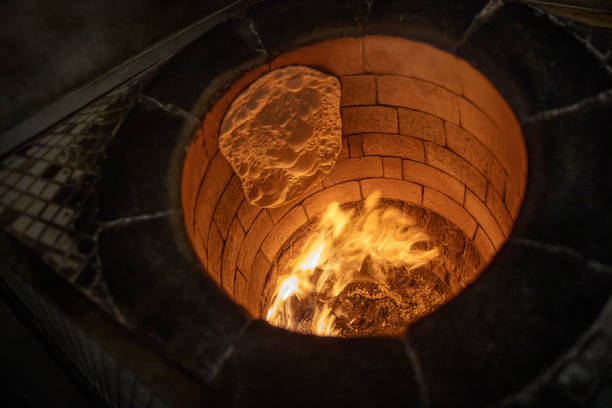The Commercial Combination Tandoor oven
The combi-tandoor oven is the most versatile piece of equipment in today’s commercial kitchen, seen by most chefs and cooks as the ‘must-have’ product. During the last 30 years it has evolved from simple manual models offering three cooking modes – convection, steam and a combination of the two – to multi-programme tandoor ovens using cutting edge technology such as the Rational 5 Senses Self Cooking Center and the Electrolux Touchline Air-O-Steam tandoor ovens.
Benefits
The benefits of the combi tandoor oven are indisputable. Powerful and complete the combination tandoor ovens can carry out multiple cooking processes such as roasting, poaching, grilling, steaming and baking with outstanding results. State-of-the-art combi-tandoor ovens cut back on shrinkage and energy resulting in huge savings to the operator. “Combi-tandoor ovens provide huge benefits because of their sheer versatility: they can be used in a variety of roles from baking bread to roasting chickens and every type of food in between,” says Andy Bridgeman, Sales Director at Akro Limited. “They can help caterers cope with complete menus whether you are an establishment cooking 30 covers or a large banqueting facility with thousands the Rational & Electrolux tandoor ovens can cope with ease”.
Choosing a Combination Tandoor oven
Chefs/Caterers choosing a tandoor oven today have a wide choice of models with varying levels of sophistication but there are two manufacturers that stand out as being the market leaders (Electrolux Professional and Rational UK). Choosing the correct tandoor oven is so critical as it is an investment and should reflect what you need from an tandoor oven. If you are after perfect cooking results with the ability to save those results and create stored menus then choose a leading brand. If you are after a basic convection tandoor oven (don’t choose a combi) the same applies if you only want to steam. Both manufacturers offer a range which incorporates both manual and programmable tandoor ovens to suit the needs of any type of operation, from large scale banqueting using a cook chill system to smaller restaurants that can exploit its multi-functionality.
Rational Tandoor ovens
Rational invented the technology in 1976, and the first combi-steamers had manual controls and were complex to operate. “With a manual model the chef has to enter all the cooking parameters – time, temperature and load,” says Lee Norton, Rational’s managing director. “In a programmable model the chef punches in the cooking requirements setting into motion preset programmes.”
Electrolux Professional Tandoor ovens
Alan Evans, executive training chef at Electrolux Professional, says the benefits of using such a “highly intelligent piece of kit” are extensive. “Early programmable models just had nine programmes each with about three steps, now they have 1,000 programmes each with 100 steps or cooking phases,” he adds. “Stored programmes can be transferred between different tandoor ovens using the USB port, adding extra convenience to chefs with multiple tandoor ovens or kitchens.”
But it’s important to match the tandoor oven to your needs so you don’t end up spending money on features you’re unlikely to use.
MAKING THE RIGHT CHOICE
Manual or Automatic – comparing a manual model with a high tech tandoor oven is a bit like comparing a top of the range car, with automatic gearbox, cruise control and built-in satnav, with a basic model with none of these features. “Both will get you from A to B, but the high spec model gets you there in a more efficient and less stressful manner. Caterers might be advised to opt for the simpler version if they wanted to use it mainly as a steamer with occasional use as a dry tandoor oven, or vice versa.” If you have multiple sites serving the same menus then it makes sense to choose the automatic (programmable) model as you can save stored menus to a USB memory stick and transfer between tandoor ovens resulting in consistent cooking results across all sites. Also we need to look at the user and the environment that they work in – if for example a ‘cook needs to use an tandoor oven to prepare and cook menus but lacks the basic skills to understand and use a manual combi the choose the Auto version yet a chef with a high skill set may want complete control and feel that he / she can make do with the manual version – it must be understood that even choosing an auto/selfcooking tandoor oven will also allow you to switch between automatic mode or manual mode (the best of both worlds)
Programmable Tandoor ovens for everyone – programmable combi tandoor ovens are suitable for just about every catering operation from Michelin star restaurants through to bakeries, take-away outlets and fish and chip shops.
“Restaurants use them for their precision and reliability of outcome. Take-aways use them for speed and ease of operation and consistency of results. Many experienced chefs prefer to operate a combi-steamer manually both to be in control and because it’s what they are used to.
KEY COMBI FEATURES
THE MANUAL COMBI
- Chefs can alter cooking methods, times and temperature very easily.
- There is usually less to go wrong with manual tandoor ovens, so the risk of downtime is lower and any repair costs tend to be less.
- Needs a level of skill and intervention to get the best results.
- Manual versions are subject to human error.
- Most entry-level combi-tandoor ovens tend not to have an automatic self-clean system.
Read: The Procedures That Are Applied During an Tandoor oven Cleaning Service
THE PROGRAMMABLE COMBI
- Consistent results whatever the venue, the occasion and the skill level of the members of staff involved.
- Many have a full interactive touch pad with images of the food which is particularly useful to overcome language barriers.
- Quick and easy for caterers to upload recipes using a USB port.
- Self-cleaning feature with some automatically adjusting detergent levels to match the degree of soiling.
